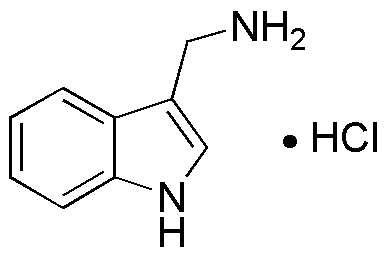(1H-Indol-2-yl)methylamine hydrochloride is widely utilized in research focused on
- Pharmaceutical Development: This compound serves as a key intermediate in the synthesis of various pharmaceuticals, particularly those targeting neurological disorders, due to its ability to interact with serotonin receptors.
- Biochemical Research: It is used in studies exploring the role of indole derivatives in biological systems, aiding researchers in understanding metabolic pathways and enzyme interactions.
- Drug Design: The compound is valuable in the design of new drugs, especially in the development of selective serotonin reuptake inhibitors (SSRIs), which are crucial for treating depression and anxiety.
- Material Science: It finds applications in creating advanced materials, such as organic semiconductors, which are essential for developing flexible electronics and solar cells.
- Analytical Chemistry: This chemical is employed in various analytical techniques, including chromatography, to separate and identify complex mixtures in research and quality control settings.
General Information
Properties
Safety and Regulations
Applications
(1H-Indol-2-yl)methylamine hydrochloride is widely utilized in research focused on
- Pharmaceutical Development: This compound serves as a key intermediate in the synthesis of various pharmaceuticals, particularly those targeting neurological disorders, due to its ability to interact with serotonin receptors.
- Biochemical Research: It is used in studies exploring the role of indole derivatives in biological systems, aiding researchers in understanding metabolic pathways and enzyme interactions.
- Drug Design: The compound is valuable in the design of new drugs, especially in the development of selective serotonin reuptake inhibitors (SSRIs), which are crucial for treating depression and anxiety.
- Material Science: It finds applications in creating advanced materials, such as organic semiconductors, which are essential for developing flexible electronics and solar cells.
- Analytical Chemistry: This chemical is employed in various analytical techniques, including chromatography, to separate and identify complex mixtures in research and quality control settings.
Documents
Safety Data Sheets (SDS)
The SDS provides comprehensive safety information on handling, storage, and disposal of the product.
Product Specification (PS)
The PS provides a comprehensive breakdown of the product’s properties, including chemical composition, physical state, purity, and storage requirements. It also details acceptable quality ranges and the product's intended applications.
Certificates of Analysis (COA)
Search for Certificates of Analysis (COA) by entering the products Lot Number. Lot and Batch Numbers can be found on a product’s label following the words ‘Lot’ or ‘Batch’.
*Catalog Number
*Lot Number
Certificates Of Origin (COO)
This COO confirms the country where the product was manufactured, and also details the materials and components used in it and whether it is derived from natural, synthetic, or other specific sources. This certificate may be required for customs, trade, and regulatory compliance.
*Catalog Number
*Lot Number
Safety Data Sheets (SDS)
The SDS provides comprehensive safety information on handling, storage, and disposal of the product.
DownloadProduct Specification (PS)
The PS provides a comprehensive breakdown of the product’s properties, including chemical composition, physical state, purity, and storage requirements. It also details acceptable quality ranges and the product's intended applications.
DownloadCertificates of Analysis (COA)
Search for Certificates of Analysis (COA) by entering the products Lot Number. Lot and Batch Numbers can be found on a product’s label following the words ‘Lot’ or ‘Batch’.
*Catalog Number
*Lot Number
Certificates Of Origin (COO)
This COO confirms the country where the product was manufactured, and also details the materials and components used in it and whether it is derived from natural, synthetic, or other specific sources. This certificate may be required for customs, trade, and regulatory compliance.


